Flat and Low Slope Roofing in Vancouver
Sleek, modern roofing solutions for Vancouver’s diverse architecture.
Flat Roofing in Vancouver: A Practical and Modern Choice
Vancouver’s architectural landscape is constantly evolving, embracing modern designs that emphasize clean lines and efficient use of space. Flat and low-slope roofs have become increasingly popular in the city, offering a versatile and practical roofing solution for both residential and commercial buildings.
Eco Exteriors offers flat and low-slope roofing installations, providing Vancouver homeowners and businesses with durable, high-performing roofs that complement their architectural vision. Our team of experts understands the unique challenges of this roofing style and utilizes the latest materials and techniques to ensure your roof is built to last, even in Vancouver’s rainy climate.
Whether you’re looking to create a rooftop patio, install solar panels, or simply want a modern, low-maintenance roof, Eco Exteriors has the expertise and experience to bring your flat roofing project to life.
Our Flat Roofing and Low Slope Roofing Options
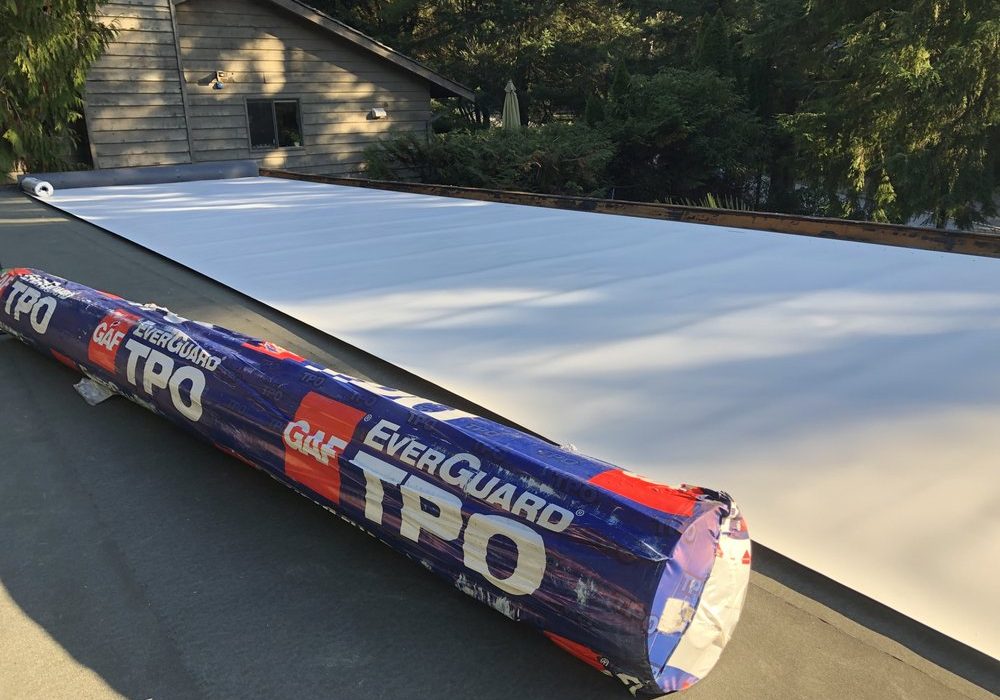
TPO/PVC Roofing
TPO (Thermoplastic Polyolefin) and PVC (Polyvinyl Chloride) are both popular choices for flat roofing due to their affordability, durability, and energy efficiency. These single-ply membranes are heat-welded together, creating a seamless, watertight surface that protects your home or business from leaks and moisture damage.
Benefits of TPO and PVC Roofing
- Versatility: TPO and PVC can be installed over your existing roof or as a new system, offering flexibility for your project.
- Energy Efficiency: Both materials are highly reflective, helping to reduce your cooling costs and meet Energy Star guidelines.
- Durability: TPO and PVC are resistant to punctures, tears, and UV damage, ensuring long-lasting performance.
- Warranty Options: We offer a variety of warranty options for TPO and PVC roofing systems, providing you with peace of mind in your investment.
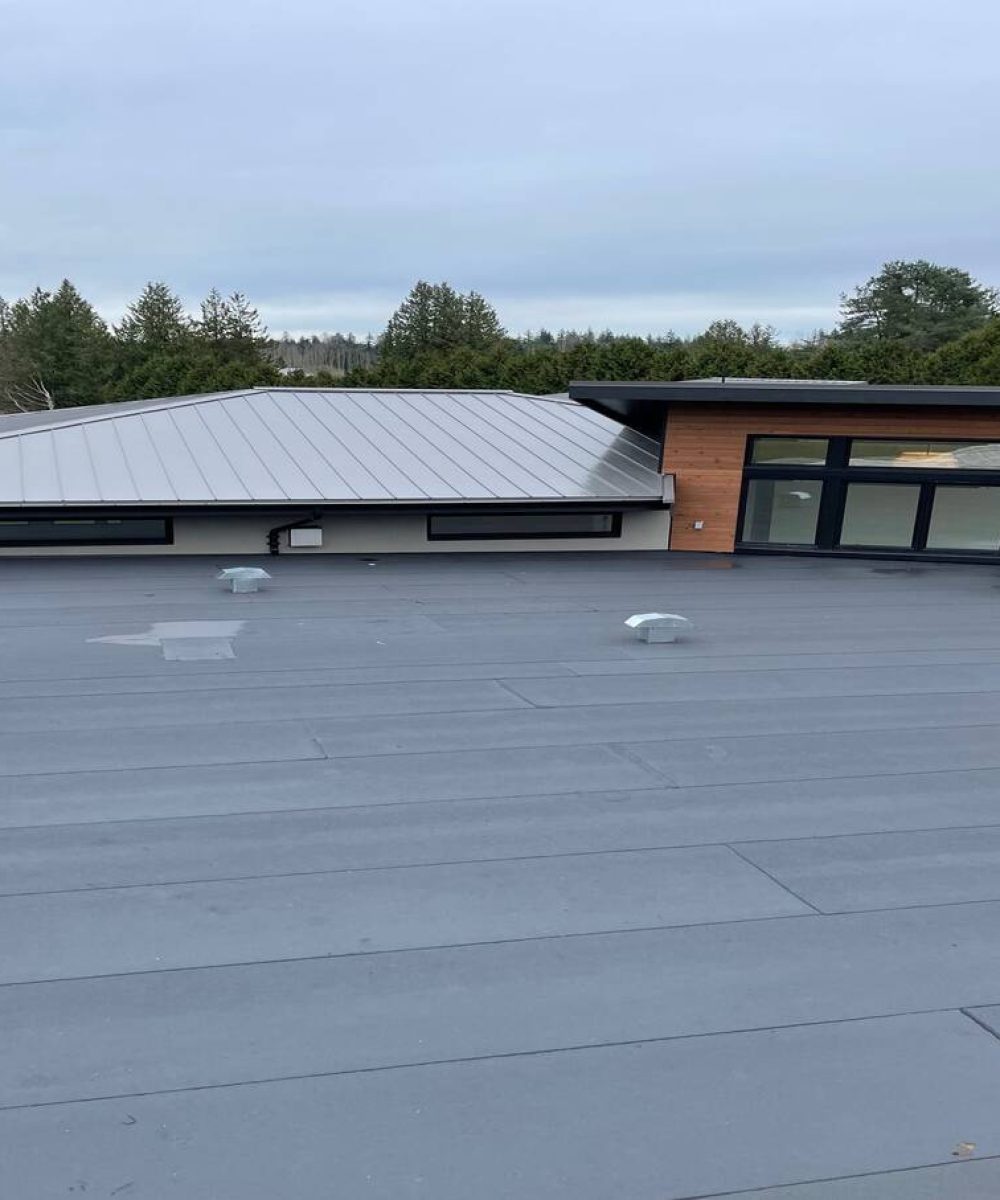
Cold Ply Torch On (Flameless)
At Eco Exteriors, we believe in staying ahead of the curve, embracing innovations that benefit both our clients and the environment. That’s why we’re proud to offer Cold-Applied Torch On (Flameless) Flat Roofing, a cutting-edge solution that’s transforming the industry.
Flameless roofing is a modern approach to installing modified bitumen (mod-bit) roofs without the use of open flames or torches. This eliminates the risk of fire hazards during installation, making it a safer choice for your home and our community.
The environmental benefits are equally significant. Flameless roofing reduces harmful emissions associated with traditional torch-on methods, contributing to a cleaner and healthier environment. It’s a choice that aligns with our commitment to sustainable practices and a greener future for Vancouver.
Benefits of Flameless Torch On
- Safety: Eliminates fire hazards and reduces risk during installation.
- Sustainability: Reduces air pollution and harmful emissions compared to traditional torch-on methods.
- Year-Round Installation: Allows for roof installation in colder temperatures, expanding your project timeline options.
- Superior Quality: Provides consistent adhesion and stronger welds, resulting in a more durable and long-lasting roof.
- Healthier for Installers: Eliminates exposure to harmful fumes associated with torch-on methods.
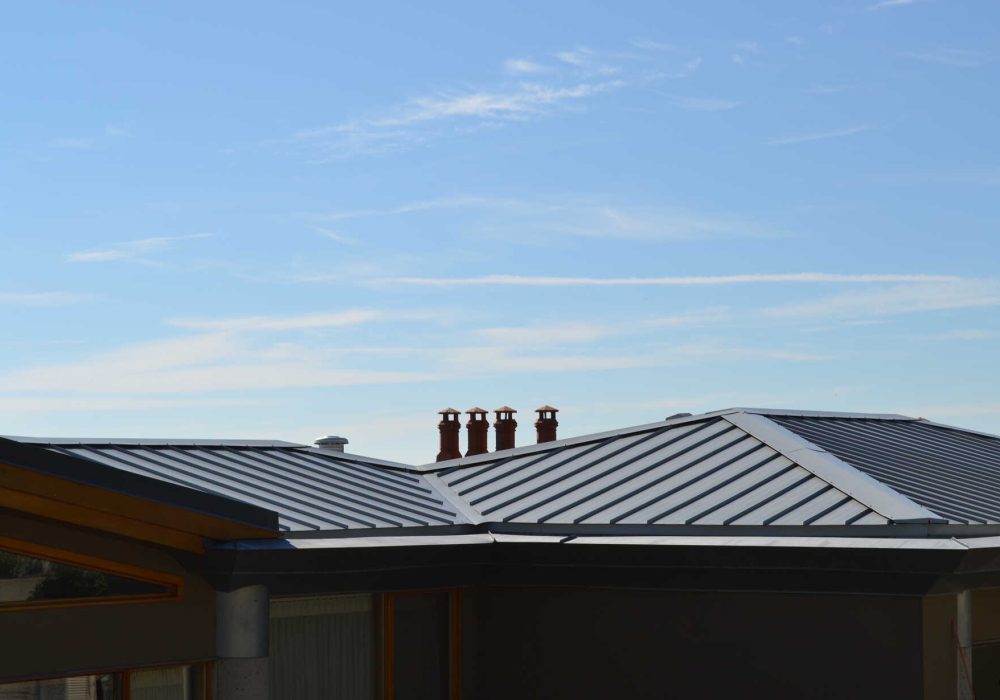
Metal Roofing
When it comes to protecting your Vancouver home with a low-slope roof, metal roofing stands out as a superior choice. Eco Exteriors specializes in two premium metal roofing systems, both designed for exceptional durability, longevity, and performance on low slopes.
Eco-Lock Metal Roofing
Our Eco-Lock Metal Roofing system is a top choice for homeowners seeking a seamless and efficient solution for their low-slope roof. Crafted from high-quality metal panels, Eco-Lock features a unique snap-lock design that creates a continuous, watertight barrier against the elements. This innovative system eliminates the need for exposed fasteners or caulking, minimizing the risk of leaks and ensuring long-lasting protection for your home.
Standing Seam Metal Roofing
For homeowners seeking a premium option with exceptional durability and a distinctive architectural look, standing seam metal roofing is an ideal choice. This system features raised seams that run vertically along the panels, adding a touch of elegance and sophistication to your home’s exterior.
Benefits of Metal Roofing
- Unmatched Durability: With a lifespan that can easily exceed 50 years, Metal Roofing is a long-term investment that will protect your home for generations.
- Energy Efficiency: Metal reflects the sun's rays, reducing heat absorption and lowering your cooling costs.
- Sustainability: Our metal panels are made with recycled content and are 100% recyclable at the end of their lifespan.
- Aesthetics: Choose from a variety of colours and finishes to create a sleek, modern look that complements your home's architecture.
- Lifetime Warranty: We offer a Lifetime Warranty on materials and workmanship for your piece of mind.
Flat vs. Pitched Roofs: Understanding the Difference
When considering a new roof for your Vancouver home or business, one of the first decisions you’ll need to make is whether to go with a flat or pitched roof. Each style has its own unique advantages and disadvantages, and the right choice for you will depend on your specific needs and preferences. Let’s explore the key differences between these two types of roofs.

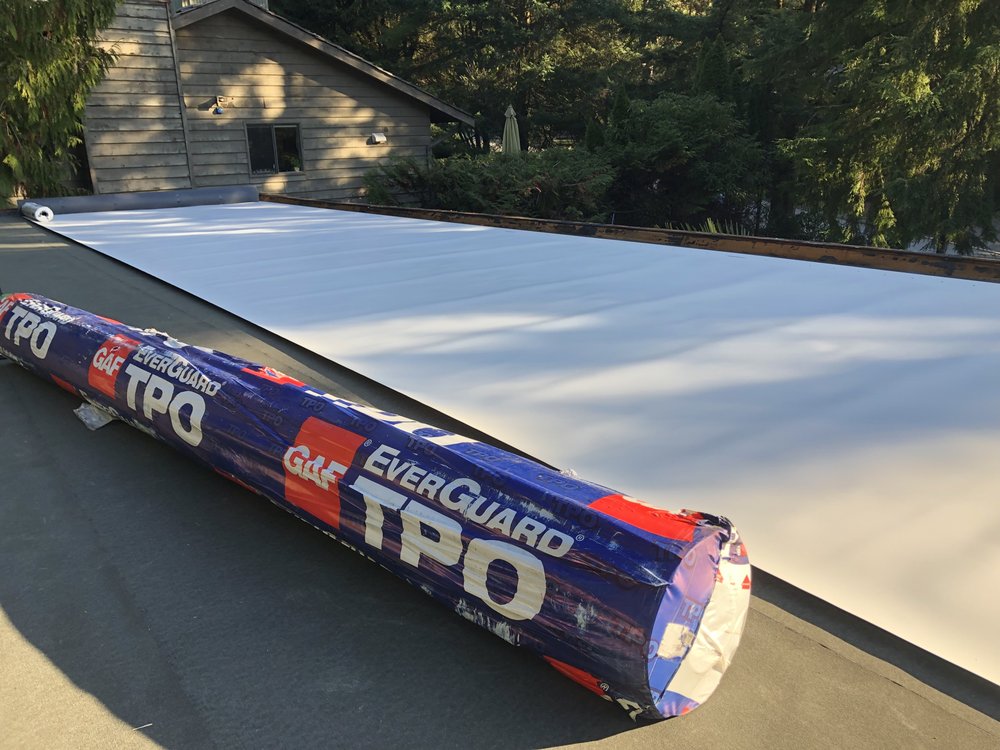
What Defines Flat and Low Slope Roofs?
The terms “flat roof” and “low slope roof” are often used interchangeably, as they essentially refer to the same type of roof. While they may appear flat to the naked eye, these roofs actually have a slight slope, typically between ¼ to ½ inch per foot. This subtle slope is crucial for facilitating proper drainage and preventing water from pooling on the roof surface.
How Flat Roofs Function
Unlike pitched roofs, which rely on gravity to shed water, flat roofs depend on a continuous, seamless membrane and a carefully designed drainage system to manage rainwater and prevent leaks. This membrane can be made from a variety of materials, such as modified bitumen, TPO, PVC, or even metal.
Advantages of Flat Roofs
Flat roofs offer several distinct advantages that make them a popular choice for many homeowners and businesses:
Increased Usable Space:
One of the biggest advantages of flat roofs is the additional usable space they provide. You can transform your flat roof into a rooftop patio, garden oasis, or even an extension of your living space. This extra square footage can significantly increase the value of your property and enhance your lifestyle.
Accessibility and Safety:
Flat roofs are much easier and safer to access than pitched roofs, making maintenance, repairs, and installations (such as solar panels) simpler and less risky.
Design Versatility:
Flat roofs lend themselves well to modern architectural styles, offering a sleek and minimalist aesthetic that complements contemporary homes and buildings.
Choosing the Right Flat Roofing System for Your Home
The best flat roofing system for your home will depend on your specific needs and budget. Our team at Eco Exteriors can help you assess your options and recommend the ideal solution based on your roof’s size, slope, and exposure to the elements.
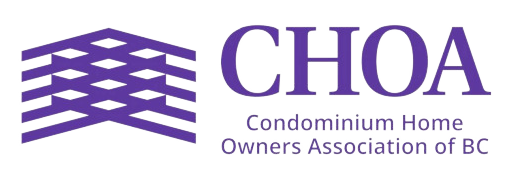


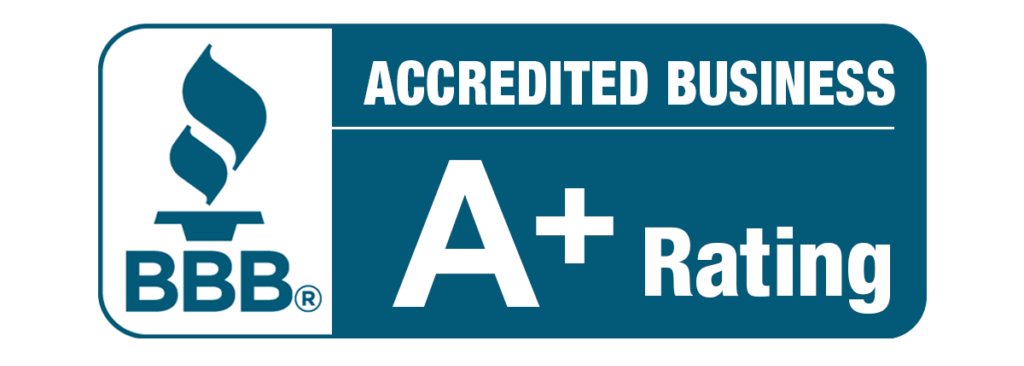

Disadvantages of Flat Roofs
While flat roofs offer many benefits, they also come with some potential drawbacks:
Drainage Challenges:
Compared to pitched roofs, flat roofs are more susceptible to drainage issues, especially in heavy rain or snow. Ponding water can put extra stress on the roof membrane and potentially lead to leaks if not addressed promptly.
Sun Damage:
Flat roofs receive more direct sunlight than pitched roofs, which can accelerate the deterioration of certain roofing materials.
Solutions to Mitigate Drawbacks
Proper Drainage:
Eco Exteriors ensures that your flat roof is designed and installed with adequate drainage to prevent water accumulation.
Protective Coatings:
For roofs exposed to high levels of sunlight, we offer protective coatings or membranes that reflect UV rays, minimizing the risk of sun damage and extending the lifespan of your roof.
Flat Roof Maintenance: Proactive Care for Long-Term Performance
Flat roofs, like any roofing system, require regular maintenance to ensure optimal performance and longevity. While they generally require less upkeep than sloped roofs, proactive care is essential to prevent leaks, damage, and costly repairs.
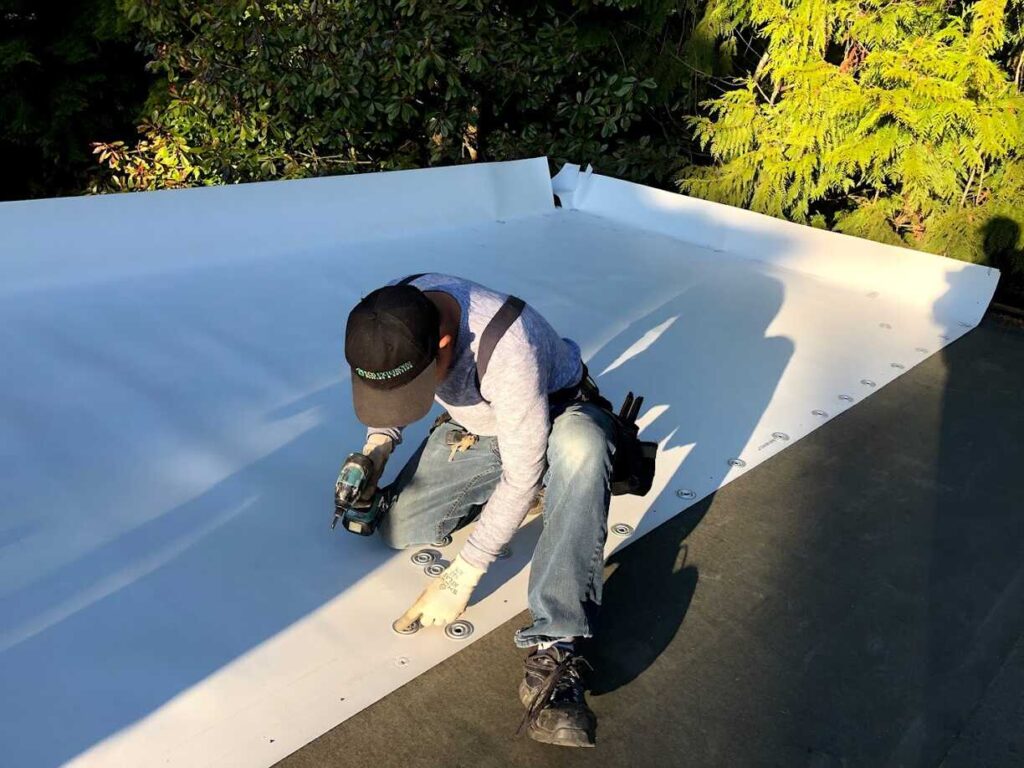
The Importance of Maintenance for Your Flat Roof
Regular maintenance is a small investment that can yield significant returns in the long run. By keeping your flat roof well-maintained, you can:
Extend Roof Lifespan:
Identifying and addressing minor issues early on can prevent them from escalating into major problems, saving you money and extending the life of your roof.
Prevent Leaks and Water Damage:
Regular inspections and cleaning can help you catch leaks before they cause extensive damage to your home's interior and structure.
Preserve Energy Efficiency:
A well-maintained flat roof can help maintain your home's energy efficiency by ensuring proper insulation and preventing heat loss or gain.
Protect Your Investment:
Your roof is a valuable asset. Regular maintenance helps to protect your investment and avoid costly repairs down the line.
Cleaning and Inspections: Keep Your Flat Roof Debris-Free
- Regular Cleaning: Remove leaves, debris, and any standing water from your flat roof at least twice a year, preferably in the spring and fall. Use a soft broom or leaf blower to avoid damaging the membrane.
- Check for Damage: During your inspections, look for any signs of damage, such as punctures, cracks, or blisters in the roofing material. Also, check the flashing around vents, pipes, and other roof penetrations for any gaps or leaks.
Repairing Leaks and Punctures
Even with regular maintenance, leaks can sometimes occur. If you notice a leak, it’s important to act quickly to prevent water damage and further deterioration of your roof.
- Small Leaks: Minor leaks may be able to be repaired with sealant or patches, depending on the roofing material.
- Larger Leaks: More extensive leaks may require replacing sections of the roof membrane or flashing.
- Professional Repairs: It’s always best to consult with a professional roofing contractor like Eco Exteriors to assess the damage and determine the best repair solution.
FAQ: Your Questions Answered
The lifespan of a flat roof depends on the material used and how well it's maintained. With proper care, TPO and PVC roofs can last 20-30 years, while metal roofs can last 50 years or more.
Common signs of a leaky flat roof include:
- Water stains on your ceiling or walls
- Dampness or mold in your attic
- Blistering or bubbling of the roof membrane
- Ponding water on the roof surface
If you notice any of these signs, it's important to contact a roofing professional as soon as possible to prevent further damage.
We recommend having your flat roof inspected at least once a year, preferably in the spring, to check for any signs of damage or wear and tear. If your roof is older or has experienced recent weather events, more frequent inspections may be necessary.
Yes, we offer flexible financing options to help make your flat roof installation more affordable. Contact us to discuss the available options and find a plan that fits your budget.
Your Vancouver Flat Roofing Solution Awaits
Ready to explore the possibilities of a modern, practical, and durable flat roof for your Vancouver home or business? Eco Exteriors is your trusted partner in flat roofing, offering expert guidance, premium materials, and top-notch craftsmanship.
Whether you envision a rooftop oasis, a sleek modern addition, or simply want a reliable and low-maintenance roof, we can help you bring your vision to life. Our team of experienced professionals will work closely with you to design and install a flat roof that meets your specific needs, budget, and aesthetic preferences.
Don’t wait to discover the benefits of flat roofing for your Vancouver property. Contact us today for a free consultation and estimate. We’ll assess your roof, discuss your options, and help you choose the perfect flat roofing solution that will elevate your home or business.





